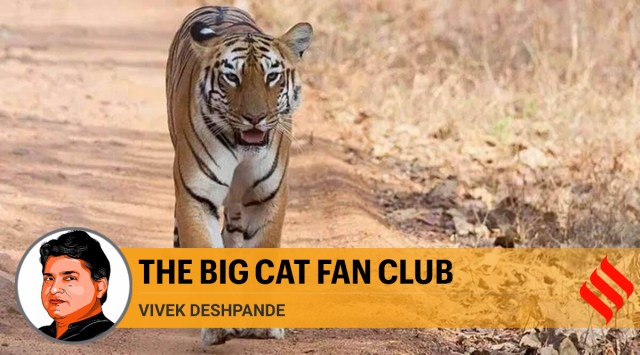- India
- International
People’s love for ‘superstar’ tigers and what it can teach us
For forest department and conservation officials, the baggage of public sentiment is not always welcome. But support for individual tiger “celebrities” is an opportunity.
 Left without their mother, the cubs, including PTRF_84, were reared in captivity.
Left without their mother, the cubs, including PTRF_84, were reared in captivity.THE death of PTRF_84, a three-year-old tigress, at Pench Tiger Reserve last week brings the curtains down on one of the most popular “tiger stories” of recent times. The tigress was not an ordinary one, but the “cub of Avni”. The mother had been shot down in November 2018 in Yavatmal district of Vidarbha, as she had been involved in several human deaths, prompting an outcry about the cost of human-animal conflicts. Left without her mother, PTRF_84 was reared in captivity. After two years of rewilding, she was released into the forest, but she could survive only a day — she was killed in a turf fight with another animal. The life and death of Avni and her daughter, and the response it evoked in ordinary people, is an illustration of an increasing emotional entanglement with tigers. For the forest department and conservation officials, however, the baggage of public sentiments is not always welcome.
The forest department had to first deal with an outpouring of emotion when Avni, officially T1, was shot dead in the forest of Pandharkawada in Yavatmal district, under government orders after being declared a man-eater. In 2016, Jai, beloved to be India’s biggest tiger, had mysteriously disappeared from the Umred-Paoni-Karhandla Wildlife Sanctuary in Nagpur district, leading to a public outcry that snowballed into a political issue. The then-Devendra Fadnavis government was at pains to defend itself, with activists as well as the Opposition upping the ante. Of late, another tiger nicknamed Walker, also in Pandharkawada, found global limelight due to its epic journey of over 3,000 km over six months to reach a sanctuary in Buldana district. Just as he seemed to have settled down there for good, the news of his disappearance for the past month and a half has tiger lovers and activists worried again.
Wildlife officials, however, are not too enthusiastic about this continuous monitoring by activists as well as the media. They tend to look at such episodes as routine and inevitable in tiger ecology. They argue that as long as tiger numbers are growing, the disappearance of a particular tiger shouldn’t be hyped into an emotive issue. The occasional and “necessary” shooting of a tiger declared man-eater should also not be subjected to a gruelling scrutiny as it not only brings down the forest staffers’ morale but also shapes their response to such incidents in the future. What’s the big deal about a certain tiger not being spotted, they ask. Tigers have their own ways of survival and keeping track of an individual tiger can’t be the focal concern of conservation, whose mandate is to attend to the whole species and not an individual.
While their view can’t be faulted, they can ignore growing public sentiment only at the risk of coming across as rigid and non-accommodative. To say that Jai or Walker are like any other tiger is far from being true. They are superstar big cats who attract not just ordinary tiger lovers but also celebrities. When Jai walked in Umred sanctuary, it had become a huge tourism hotspot with national and international cricketing and film celebrities making a beeline to see the 250-kg male who ruled vast tracts of forest. Walker, too, has earned his place in tiger folklore with his marathon walk. His radio collar was removed last year and that has made tracking his movement difficult. With no indirect signs of his presence for a while, it is natural for ordinary tiger lovers to ask questions about his well-being. There are many tigresses in the Pench Tiger Reserve in Madhya Pradesh but the famous Collarwali Baghin continues to be the darling of tiger enthusiasts due to her being one with the most (seven) litters on record yet. This is not to suggest that the managers should focus only on these “celebrity” tigers. But they can’t ignore the great, often excessive, public interest in individual tigers. By letting their attention slip, they only invite the question that if they can’t take care of such special tigers, what must be the quality of conservation of the several others that anonymously roam the forests?
The attention on tigers also presents itself as an opportunity for the department to unlearn some of their ineffective conservation strategies. In Avni cub’s case, for example, the forest department’s decision to release her in the immediate neighborhood of the enclosure where she underwent “re-wilding” had all the trappings of a failed mission. The tigress had got injured earlier in a clash with a resident tigress that had reportedly attacked her from outside the enclosure. So, it was only to be expected, with much greater probability, that such attacks would recur after her release into the wild.

The officials had also considered the option of moving her to Dnyanganga wildlife sanctuary, as a potential mate for Walker. But they shied away from it as it would have entailed developing the island-like sanctuary with corridor connectivity for the future tigers to escape the prospect of in-breeding. In the end, the easier option proved fatal for the tigress. And Walker, too, went missing, perhaps in search of a mate. No wonder conservationists and tiger lovers are in distress.
This column first appeared in the print edition on March 17, 2021 under the title ‘The big cat fan club’. vivek.deshpande@expressindia.com
40 Years Ago
EXPRESS OPINION
More Explained
Apr 16: Latest News
- 01
- 02
- 03
- 04
- 05









































